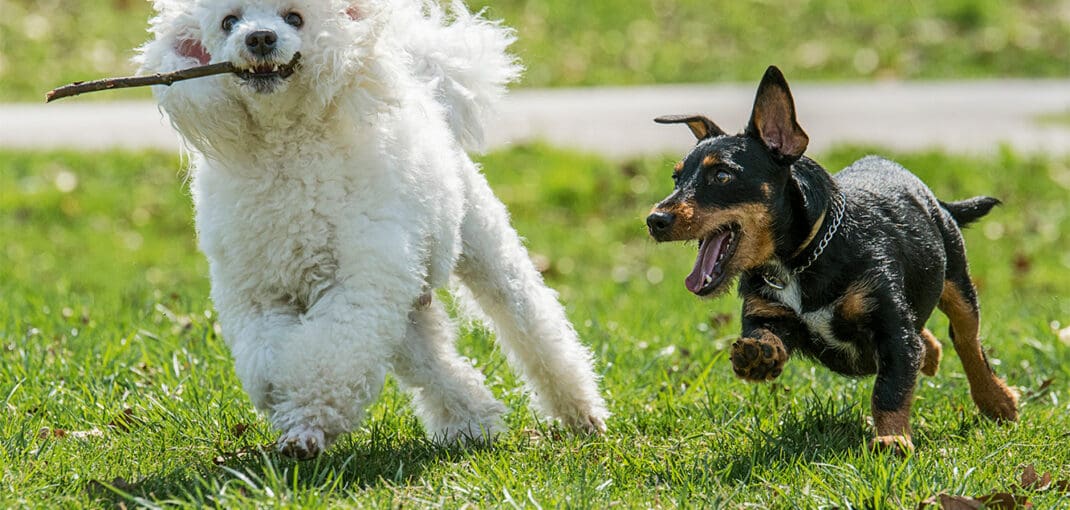Play between dogs can take many forms. Much depends on the age, temperament and relationship between the four-legged animals. During daily interactions, young animals learn about each other, discover boundaries and possibilities, develop the ability to control emotions, refine hunting instincts, build social relationships and learn about breeding behaviour. Each dog has its own preferences for the course of such an activity. It is not uncommon for a dog to be in the company of members of the same breed, with whom it is quicker to establish a bond. Typical scrambles include chasing, wrestling, biting, jumping, tumbling, carrying a toy, pulling ears or tail, biting paws, leading by the collar or harness, digging holes or swimming together – all of which resemble a carefree form of entertainment. However, sometimes what at first glance looks like innocent pranks can turn into serious conflict. So how do you tell the difference between joyful interaction and aggression? And when should a carer react?
What are the characteristics of doggy play?
Interaction between the four-legged animals often looks very intense, but in reality it is full of signals indicating that both parties agree to spend time together. Here are some typical characteristics of proper play:
Relaxed bodies – pets move smoothly, are not tense, and do not freeze in stillness.
Playful bows – the pet leans the front part of the body while the back part remains raised – this is an invitation to joint activity.
Role changes – once one pooch is chasing, the other is chasing, the roles are exchanged.
Breaks and pauses – the carer may notice brief moments of respite, during which the animals seem to reassure themselves that the other party is still keen to play further pranks. Sometimes they lie close to each other during these moments.
No signs of stress or aggression – ears and tail are “soft”, the quadruped does not growl or show teeth in an alarming manner. Animals move freely, without tension, often side by side.
Social behaviour – the pet may bring a toy to another or take it away, provoking a chase. They often do this deliberately, turning around so that their companion notices what is happening and can keep up. They then increase their pace or change their running direction.
When does fun turn into a fight?
Sometimes one party stops enjoying a shared activity and the other does not notice or ignores it. Conflict often starts subtly, so it is helpful to know the warning signs:
Body stiffness – quadrupeds suddenly tense up, their movements become fast and lack fluidity.
Intense staring – instead of intermittent eye contact, there is persistent eye measuring.
Lack of role changes – one animal continually remains in the role of the dominant party while the other tries to withdraw.
Lack of interruptions – the interaction degenerates into a continuous attack, with no moments to stop or rest.
Disturbing sounds – growling, barking, snapping muzzle and even biting combined with jumping can be heard. These noises vary in tone from those associated with play and may also include squealing or whining.
Signs of stress – laid back ears, tucked tail, licking, yawning, attempts to escape, hiding behind handler’s legs or in tight places.
What to do when play stops being fun?
The most important thing is to observe. Even if the dogs were having a great time at the beginning, the situation can change in a matter of seconds. If you notice that one of the four dogs is trying to move away, whimpering, running away and the other is chasing it – don’t wait! React immediately.
It’s a good idea to have a leash, a toy or training treats with you to distract your dog if necessary, or just to call him and take a short break.
If your pet doesn’t respond to being called, continues to run away and the other dog is chasing him – approach him, stand between them and block the intruder’s access. If the situation does not improve, put the trailing dog on a leash and ask its handler to take it away.
After such an unsuccessful game, be sure to let your dog vent his emotions. Plan your next meeting with your canine pal to rebuild the positive associations associated with playing together.
Never put your hands between fighting dogs – the safety of both people and animals is paramount in a fight situation. Try to separate the four dogs with an object such as a blanket, large bag or sticks.
It is worth remembering that not every dog is comfortable playing with other pets. This is influenced by, among other things, the level of socialisation, previous experience, social competence, habits and the reactions of the carer. Dogs with less social skills should meet other pets under the guidance of an experienced trainer or behaviourist, accompanied by a suitably matched, stable companion.
Play between dogs is a special time – both for the animals themselves and their carers. Being active together develops relationships, teaches communication and helps to discharge excess energy. As guardians, however, we have a responsibility to ensure that it is safe and enjoyable for all participants. Vigilance, careful observation, knowledge of your pet’s body language signals and quick reactions – these are the keys to successful and safe play.






